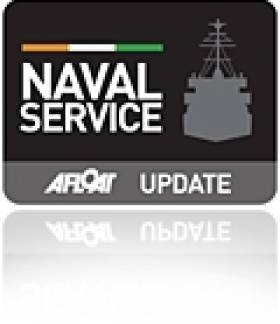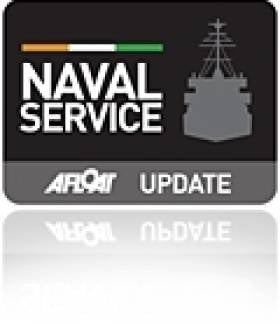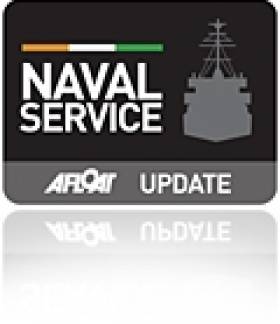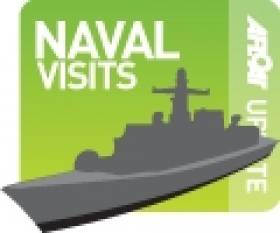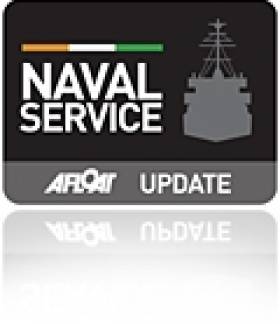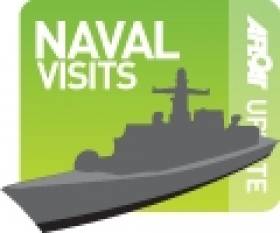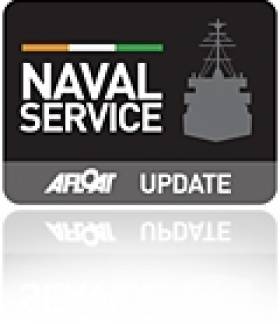Displaying items by tag: Navy
Naval Service to Sell Off Pair of Older Patrol Vessels
#NavalService – Two Irish-built navy patrol ships launched at Verolme Cork Dockyard, are to be sold off after 40 years of service according to the Herald.
LE Emer (P21) and a sister ship LE Aoife (P22) were built between 1978 and 1980 at the Rushbrooke shipyard near in Cobh, Co Cork.
The first ship of four in the Offshore Patrol Vessel (OPV) class built in Cork in 1972, the LE Deirdre (P20) , was decommissioned in 2001 and sold for €190,000. She was later converted into a luxury yacht.
The two ships will be replaced by two new OPVs currently under construction in the UK.
Naval Service ‘Flagship’ Visits Adopted Homeport of Flag Festival and Irish Diaspora Forum
#FlagshipsHomeport -With newcomer Dublin Bay Cruises running from the East Pier jetty in Dun Laoghaire Harbour, this led to the Naval Service 'flagship' L.E. Eithne (P31) having to take a different berth than usual at her adopted homeport, writes Jehan Ashmore.
The recent two-day call of L.E. Eithne saw the flagship make the unusual step of berthing at Carlisle Pier, the location chosen by the Dun Laoghaire Harbour Company for a proposed Irish International Diaspora Centre, a landmark building which is to form as a focal point of the port's Masterplan.
L.E. Eithne came alongside (berth No. 3) where the conventional ferry from Holyhead used to dock until 1996. To those of a different generation, memories will recall the 'mail' boats that docked also on the adjacent berth that faces the East Pier. Going back further was the era of the steam-packets that also plied the 60 nautical mile route to Anglesea.
Together these forms of vessels can trace the history of some 200 years of passenger services linking Ireland and Wales, and where Carlisle Pier was the embarkation point for thousands of Irish emigrants who set off to a begin a new life with our nearest neighbour and beyond.
As for the flagship the L.E. Eithne, she has represented the state proudly as a floating ambassador during her near 30 year career. She has visited many shores aboard, notably as the first Naval Service vessel to cross the Atlantic in 1986, where she sailed to the United States visiting Hamilton, New York, and Boston.
Such seafaring voyages that 'fly the flag' strengthen the ties between nations and heightens the importance of history, heritage and the cultural identity of flags and emblems.
On a related note the Genealogical Society of Ireland and the National Maritime Museum of Ireland, are to jointly host The Bratacha Festival of Flags and Emblems 2013 in the museum which is open to visitors free of charge on Friday 10 and Saturday 11 May.
Following the festival, the third Global Diaspora Forum, which is a celebration of the 70m Irish diaspora and is to be held in Dun Laoghaire on 14-15 May.
The forum has been held annually in Washington and, this year, it will run simultaneously in Washington and Dublin: primarily in the Killiney Castle Hotel and Dun Laoghaire County Hall.
Naval Service Detains Northern Ireland Fishing Vessel
#Trawlerdetention – The skipper of a Co. Down fishing vessel is due in court in the Republic after the Irish Naval Service detained the boat off the Co. Galway coast.
It is understood the skipper of the Kilkeel based vessel was detained on suspicion of fishing illegally inside the Republic's waters.
The Archane, was boarded by the Irish navy on Tuesday afternoon, about 11 nautical miles south of the Aran islands.
The fishing vessel was then escorted by the Irish naval vessel, L.É.Aoife (P22) to Rossaveal. To read more the BBC has a report.
#NavalService- L.É. Ciara (P42) recently made a surprise visit to Youghal, from where the coastal patrol vessel (CPV) was carrying out navigation exercises at the harbour mouth.
On board was Officer Commanding Lt Cdr Brian Sweeney with a crew of 40 approx. Locals and tourists saw the CPV from the vantage points along the quayside.
Among the onlookers were the proud parents of Chief Petty Officer Michael ( Rocky) Cashell from Youghal who was at the wheel of the LÉ Ciara as she steamed up the river Blackwater.
To watch a video of the L.É. Ciara during her brief visit and to read more YoughalOnLine has a report
The small port engages in the export of timber products which are served by coasters.
As previously reported on Afloat.ie, the sale-listed 113 year-old 'Kathleen and May' a historic West Country schooner, made frequent calls to the port town up to the 1960's.
On these calls she would be typically laden with coal having made passage from Bristol.
Liverpool’s ‘Lusty’ Valentine Marks Changing Times for Aircraft-Carriers
#AircraftCarriers – The Royal Nay's last 'Invincible' aircraft carrier, HMS Illustrious (R06) affectionately known by her crew as 'Lusty', which these days serves as a helicopter commando-carrier, docked on St. Valentine's Day at Liverpool Cruise Terminal, writes Jehan Ashmore.
As previously reported, during her five-day city courtesy call, she is to be open to the public this weekend. The call to Merseyside could be her last as the 22,000 displacement tonnes vessel is due to pay off in early 2014. She was launched in 1978 from Swan Hunter on the Tyne and over the next 32 years the 209m long vessel has served an illustrious career including her role in carrying 'Harrier' VSTOL jump jets.
The Portsmouth based HMS Illustrious is one of four Royal Navy core amphibious vessels, and in her place are a pair of Queen Elizabeth class 65,000 displacement tonnes aircraft –carriers currently under construction. However until delivered, HMS Ocean (L12) a helicopter carrier of 21,500 tonnes will replace Illustrious, after completion of a £65m refit at Devonport Royal Dockyard early next year.
Former Aircraft Carrier HMS ‘Lusty’ Open to Public Following Valentine Call
#AircraftCarrier- HMS Illustrious (R06) the Royal Navy's helicopter commando carrier is due to arrive in Liverpool on St. Valentine's Day and be open to the public next weekend (16-17 February), as part of a five-day call, writes Jehan Ashmore.
For more than three decades the former aircraft-carrier (equipped with Harrier jump-jets) has served the Royal Navy, however she is to pay-off in 2014, to make way for next generation aircraft-carriers.
Affectionately known as 'Lusty' to her crew, she is due berth alongside Liverpool Cruise Liner Terminal tomorrow at around 2pm, opposite the famous Liverpool waterfront skyline. There will be free public tours during Saturday and Sunday (10am – 4pm) noting the latest time to board is 3pm.
She forms as one of four core ships of the Royal Navy's amphibious fleet, they are the helicopter carriers HMS Ocean and assault ships HMS Albion and Bulwark, the latter is the flagship.
HMS Illustrious current role is as a High Readiness Helicopter and Commando Carrier and she is the last of the 'Invincible' class aircraft carriers commissioned for the Royal Navy during the 1970's.
As previously mentioned, the class were of course equipped with the revolutionary 'Harrier II' jump-jet VSTOL aircraft built by British Aerospace/McDonnell Douglas for the RAF, until these aircraft were retired in 2010. These days she conveys a range of helicopters, Merlin, Sea King, Apaches and Lynx for the Royal Marine Commandos.
Her sisters, the decommissioned leadship HMS Invincible (RO5) was scrapped in 2005 and HMS Ark Royal (R07), the final of the class launched in 1981 made a farewell tour around Britain in 2011. Last year it was announced that she too would be scrapped.
Fishing Vessel Detained off South-East Coast
#NAVY– The Naval Service has detained a fishing vessel off the south-east coast over alleged breaches of fishing regulations, reports the Irish Examiner.
The L.E. Emer (P21) detained the Irish-registered boat around 19 nautical miles from Mine Head in Co Waterford yesterday evening.
The vessel was escorted to Cork and handed over to Gardaí in the early hours of this morning. More than 1,200 boardings and 17 vessels have been detained by the navy so far this year.
Where the 'Mersey' Meets the Lee
#NAVAL VISIT- The Royal Navy's River class patrol vessel HMS Mersey (P283) is currently moored in Cork City, at the South Quay on the River Lee, having arrived yesterday, writes Jehan Ashmore
The vessel which has crew of 45, is employed on enforcing UK and EU fishery protection law while out on surveillance duties, which can be at least 275 days annually. Boarding parties are sent out from the ship to inspect fishing vessels to make sure they have the right nets, the right log books and the right licences.
The patrol vessel was built by Vosper Thornycroft in Southampton, and she can be also used for anything from fire-fighting to disaster relief operations.
Navy Detain Irish Fishing Vessel off Blasket Islands
#FISHERY DETENTION - Naval Service OPV L.É. Aisling (P23) detained an Irish registered fishing vessel approximately 100 nautical miles west of the Blasket Islands, Co Kerry, yesterday afternoon.
The detention was in relation to alleged breaches of fishing regulations and recording of catch. According to the Naval Service, the detained vessel was under escort by the L.É. Aisling to Castletownbere and was expected to arrive this morning and then handed over to the Gardaí.
Earlier this month the Naval Service detained a French registered vessel, 170 nautical miles west of Castletownbere. The navy has detained 17 vessels in total so far in 2012.
French Registered Vessel Detained off Castletownbere
#FISHERY DETENTION – A French registered fishing vessel, was detained by the Naval Service OPV L.É. Roisin (P51) approximately 170 nautical miles West of Castletownbere, Co. Cork last night.
The detention was in relation to alleged breaches of technical fishing regulations. The detained vessel was to be escorted by the offshore patrol vessel to Cork, and then transferred to the Gardaí.
Last week the navy detained an Irish registered vessel on the same grounds and also for alleged under-recording of catch, in waters 60 miles off Roches Point, as previously reported on Afloat.ie
This latest detention by the Naval Service raises the number to 16 vessels so far in 2012.




























